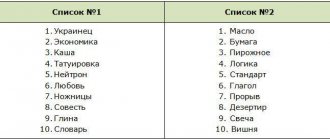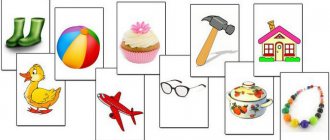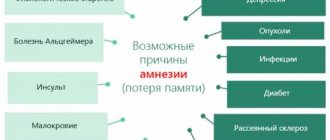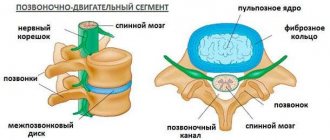Memory is one of the most important mental functions of a person. Thanks to it, we assimilate and transfer previous experience, analyze people, compare various objects. Without memory development, it is impossible to improve intellectual and thinking abilities.
The memory of a child and an adult is noticeably different in structure.
To develop a child’s memory, parents need to show diligence and attentiveness, because the baby’s future depends on it.
We have already figured out what memory is. Let's talk about the features of memory formation in children at different ages.
What is memory
All events, experiences, feelings and emotions that every person feels during his life are necessarily reflected in his personality. Memory is our amazing and mysterious property. This is remembering, preserving and reproducing past experiences. Why do we remember snippets of songs from distant childhood, but sometimes we forget what we went to the next room for? Why does our brain store telephone numbers or dates that are no longer relevant? One remembers faces better, the other remembers names. What does this depend on? It's all about what kind of memory we use.
TYPES OF MEMORY All types can be divided into three groups:
- What a person remembers is whether motor , emotional , verbal-logical or figurative memory is used.
- How he does this (by accident or intentionally) - voluntary or involuntary memory works.
- How long a memory is stored - it is sent to short-term , long-term or operational memory.
Motor (or motor) memory is everything related to movement. Walking, writing, cycling and other skills. If we have learned something once, then it happens as if “automatically”. In children, this type of memory occurs already in the first months of life.
Emotional memory helps to retain feelings and emotions experienced in different situations. The brighter an event is, the better it will be remembered.
Only humans have verbal-logical It is expressed in memorizing thoughts, judgments and is inextricably linked with speech. We do not remember the beginning of our lives precisely because we did not know how to speak.
Figurative memory corresponds to the five senses. Auditory, visual, olfactory, gustatory, tactile - each of us develops them unevenly.
When putting memories into voluntary memory, a person makes certain efforts and techniques. Involuntarily , we remember what interests us. This process happens by itself.
Short-term memory stores information or events from a few seconds to several minutes. Then the memories either move into long-term memory (and are stored there for months, years or a lifetime) or are forgotten. The operational one is needed for specific actions, to perform one “operation”.
Age norms for memory formation at 8-11 years old
As noted above, each child’s age has its own standards for memorizing and assimilating information coming from the outside world.
Thus, we can highlight the following features of memory formation in children aged 8-11 years:
- At this stage, there is an active development of voluntary memory - the student begins to set himself a special task to learn certain information. Moreover, the processes of memorization and reproduction act as mnemonic actions,
- gradually the child begins to master memorization techniques. At first, he uses simpler techniques, for example: reviewing the material, repeating it many times, dividing information into smaller blocks,
- self-monitoring of memorization results is carried out at the level of recognition. For example, a student looks at a story and thinks that he has learned it because it seems familiar to him,
- younger schoolchildren (8-11 years old) have more developed figurative memory.
REFERENCE. Parents should keep in mind that if a child has problems remembering this or that material, measures to improve memory should be adjusted taking into account his age and the standards established in medicine.
Why is it important to develop memory in children from an early age?
It’s not for nothing that newborn children are compared to a blank sheet of paper on which nothing has yet been written. After all, memory is memories of past experiences, and babies don’t have them yet. But as they grow up, literally from the first months, babies accumulate different feelings, sensations, abilities and skills, many of which will last a lifetime. Today, people have come up with many ways to “save” important dates, events, lists, etc.: from convenient planners and checklists to reminder applications on their phones and computers. This is understandable - after all, it is much easier than storing information in your head. This is why it is so important to “pump up” your memory on your own. This will help your child:
- easy to remember facts, events, texts, etc.;
- do well in school;
- think outside the box;
- and even find a way out of difficult life situations!
You just need to remember that “poor” memory in children is often confused with underdeveloped memory. And this can be corrected by regular exercise and training.
Causes of poor memorization
In practice, there are often cases where a child has memory impairment. This condition is characterized by the inability and inability of the child to preserve, accumulate and use information received by the child when interacting with the outside world.
There are many reasons for the development of this pathological condition. The following are the most common factors that negatively affect the development of memory in a child 8-11 years old, namely:
- constant stress and overwork, which negatively affect the general psychophysical state of the child,
- previous somatic diseases, as well as a consequence of seasonal hypovitaminosis,
- unsuccessful vaccination in early childhood,
- traumatic brain injury suffered by the child,
- development of various lesions in brain structures, including tumor growth,
- diagnosed delay in speech and general development,
- manifestation of acute and chronic circulatory disorders in the head, atherosclerosis, spasm of cerebral vessels and other pathological changes.
ATTENTION. It should be noted that in most cases, poor children's memory can be corrected and improved. In this case, in no case should this moment be ignored, since in the future poor memorability can lead to the development of psychosomatic, neurological and psychological problems in the student.
Features of memory development at different ages
Age-related features of memory development can be divided into several periods.
UP TO 2 YEARS
A child's memory begins to develop at about three months. He learns to remember the faces and voices of his relatives, examines the objects and toys around him. It is very important already during this period to comment on actions, name objects, while playing with the child. This will train both the baby’s visual and auditory memory. Of all types, motor memory initially develops; by the end of the first year of life it reaches the level that is necessary for the acquisition of speech. Around six months, the child also develops emotional memory. He can cry only when he sees something that previously upset him. And, of course, the brightest moments are remembered best. At one and a half to two years, figurative memories also arise - auditory, gustatory and other ideas.
FROM 2 TO 6 YEARS
Time for rapid formation and strengthening of memory. Memorization at this age occurs automatically. Children easily and with great interest grasp new knowledge. This is the period of “whys” who are curious about everything. From about three years of age, long-term memory actively develops. The child involuntarily remembers everything that was very emotional for him. This is the most fertile time when you can use your child’s imagination by training the skill of retelling and composing stories. Information with a plot is best retained in memory. Moreover, everything is stored in short-term memory, but with regular repetition, memories will form long-term memory. If you influence different senses, then knowledge will be absorbed even faster and better!
FROM 6 TO 12 YEARS OLD
Long-term memory becomes better during this period. Already before school, children are capable of voluntary memorization; they understand that they need to try to remember what they are asked. But, as before, it is easier to retain knowledge that is interesting.
FROM 12 YEARS OLD
Teenagers 12 years of age and older have brains that function like adults. Memory develops only when new knowledge and experience are acquired and retained. Therefore, it is important to devote time not only to school, but also to various hobbies, useful hobbies and sports.
How to develop memory in a child
We terrorize preschool children with mathematical operations, syllabic teaching of reading, and clearly controlled writing. Nowhere and never, neither before school nor at school, is time allocated for the development of a child’s memory! And memory is the fastening mortar on which the bricks of knowledge are held, forming a monolithically powerful wall of education. It is much more important to develop a child’s quick memorization skills than the ability to quickly read or add two-digit numbers in their mind. A good memory is the key to successful studies, a healthy psyche and saving time. Therefore, it is better to focus before school not on acquiring skills that the child will already learn at school, but on the development of memory. There is a second reason why it is worthwhile to develop memorization skills at an early age.
The consciousness of a small child is free , it is not constrained by various taboos, it is not limited by the framework of “this cannot be.” He is not surprised that the bun can speak, the bunny builds a hut, Baba Yaga living in the forests and Koschey the Immortal are as real to the child as the cooing doves outside the window. The kid believes everything; it is not a problem for him to imagine incompatible things, to “invent” fantastic images and connect them with implausible connections. And before he loses his enchanting ability to compose, it’s worth teaching him the skills of memorization to revive. What is memory? These are our images and associations. What do we remember for many years? What once amazed us shocked us. A childhood snowman, made together with his father, with a carrot instead of a nose. And I still remember the bright orange vegetable against the backdrop of grainy March snow. The age-old sound of the sea, the slight tickling of tiny soles with warm sand, a salty-wet strand of hair that fell into the mouth and the uncontrollably causeless happiness that took possession of us... This is still alive, but the chemical formula of benzene and the decomposition of the trinomial are irretrievably lost in our memory, because behind them there are no images or sensations; they were dead to us at the stage of memorization. Memories are based on images, associations and sensations, and the stronger they are, the longer we retain the memory of them. Therefore, it is in early childhood that one should begin to develop abstract and figurative thinking as the basic foundation for the formation of good memory. And the child’s ability to easily neglect logical connections will help in this. types of memory : operational, mechanical and logical, short-term and long-term, voluntary and involuntary, direct and indirect. Memory is classified according to the type of information remembered: visual, auditory, motor; memory for words, numbers, faces. The principle of development of any memory is the same. The information that we must remember must be vivid and imaginative. We remember what amazed and shocked us. Vivid moments of life are captured, and in order to remember the required amount of information, we must color it, break it down into visual, auditory and tactile images, and try to enter into what we remember. Don’t forget that the amount of information remembered should be interesting and understandable to the child. Information that “hits the nerves” is itself remembered. Teach your child to listen to his emotions and understand them. This kind of thinking about the feelings evoked contributes to better consolidation of information. Listed below are games - exercises that will teach you to come up with associations and find similarities and differences in memorized objects and images, and organize the necessary information. Games will not only develop memory, but also color, enrich the perception of the world, and teach us to see what previously escaped our attention. 1. First you need to push the boundaries of your imagination. These unusual sentences will help: “Imagine what a soft fluffy cloud sounds like? Draw an animal that no one has ever seen, what you can feel if you touch a rainbow, draw what your mother’s perfume smells like.” 2. First, you tell the child familiar words, for example: doctor, pen, smile, and he lists for you what associations arise in his imagination, describing them according to the scheme: shape, color, smell, how they feel and taste. You write down the adjectives and then list them, the child remembers which word corresponded to which group of adjectives. The task becomes more complicated, and unfamiliar words are used to visualize images. 3. After playing the previous game, complicate the conditions, list to the child one or two, in your opinion, characteristic details of the object, and the child must remember the object. For example, white, the baby remembers - this is a doctor, smooth-long, this is a pen, red-warm, smile. 4. Take matches, buttons, small parts of a construction set, paper that can be cut, torn, or wrinkled. You dictate words to the child at short intervals, and he lays out images - associations for the words he hears and after a while, looking at the laid out figures, repeats what he heard. 5. A game to visualize words and concepts unfamiliar to the child. The baby either draws an image that has arisen in his mind or describes it verbally. “What does abracadabra, electrification, submodality look like? What do these words smell like, what do they feel like?” You can use various terms and foreign words in the game. 6. The child chooses any object and brings it to life, imagining that the selected object has intelligence and can speak and move. What he will tell you, where he will go, what he will do, what objects he will feel comfortable among. You can come up with a fairy tale about the life-being of a living thing. 7. This game is quite famous. The child lays out cards - pictures, remembers them, turns them over and names them. The task becomes more complicated over time, there are more and more cards, and there is less time to memorize them. This game is a warm-up. The next stage, you dictate the words with a pause, and the child lays out cards that are not related to your list of words and, then, looking at the cards, he reproduces the words he heard. A child, for example, lays out a picture of “ball”, you dictate the word “cabinet”, the child needs to quickly and firmly connect these two words in order to later name the word that he heard and did not see. 8. Association game. A word is called, for example, “moon” and the child lists his associations for this word: moon - space - stars - planets - aliens... Then the last word of the associative chain is called and the child must reproduce all the link words in reverse, from the last word to the first. If we remember NLP and its classification according to the leading modality: visual learners perceive the world through visual images, auditory learners through hearing, kinesthetic learners through sensations, then it is clear that visual learners will try to see what should be remembered. Therefore, parents of a visual child should focus on the development of tactile and auditory memory, which is the least developed. These games not only develop memory, but also test the baby’s abilities, showing his “weak” or underdeveloped types of memory. For example, a baby easily remembers visual images, but is “slow” when remembering by ear or in establishing logical associations. In order to help the baby, let's turn to memorization techniques. Logical patterns help connect memorized information with a logical connection. If you need to remember a list of unrelated words or images, then you come up with a logical connection, which subsequently helps you pull out word by word and restore the entire list. A connected story is compiled from scattered words, and then, when reproduced, the composed text is remembered, and the necessary words are isolated from it. Consistent associations - it is not the words themselves that are remembered, but the associations that are invented for them. This technique is used when something abstract needs to be remembered: foreign words or concepts, then an association is invented for each “meaning nothing” word, and so it is remembered. Phonetic associations. The essence of the method is the selection of consonant associations. The method is good to use when memorizing foreign words. For example, when memorizing the English word “ball” - ball, it seems that you were hit by the ball and you felt pain. Autobiographical associations , associations with actually experienced events. For example, you need to memorize a text about the life of sea fish. Your memory immediately comes to mind of your trip to Egypt, snorkeling and many bright fish swimming nearby. And by “attaching” the facts and content to your memory, you can easily remember the text. Coloring and deepening. Transformation of information, black and white image - into color, small - into large, flat - into three-dimensional. Exaggerated images are well remembered. Entry - to enter inside the picture being presented, to become a participant in it. Co-sensation allows you to enhance ideas, feel the roughness, taste, color, smell, sound of the imagined image. This method is called tactile, olfactory memory. Any “something” can be imagined in the form of an object that has size, shape, color, smell, texture, and we extremely rarely use the next two components. Try to define the word “genetics” by touch, and what does the word “transcription” smell like? Redundancy. To remember, more information is used than is in the source material. The emphasis is on minor details. This involves the ability to see and feel more than what actually exists. Alphanumeric code. Digital information is more abstract than verbal information, so recoding, that is, animation, is important. We represent the numbers from 0 to 9 in the form of shaped hooks. For example, 1 is a stick, 2 is a swan... 9 is an inverted castle. And when memorizing a series of numbers, we capture images of numbers, connecting them with the above methods. In order to avoid confusion in the reproduction of multi-digit numbers, several images - hooks - are invented for each number from 0 to 9. For example, 8 – matryoshka, glasses, bow, snowman. Cicero's method. Using this method, remembered images and objects are located in a familiar room. Then it is enough to remember the room for the necessary information to emerge. Combined method. The more associations that acquaintance with new information causes, the stronger the memorization. Therefore, exaggerate, color, make it move, revive, become the actor in the information chain, replace in order to strengthen the image, connect in an unexpected, impossible way in life. Make the information you remember unique; it should be a multi-colored fireworks display of lights in your memory. Having trained, you will begin to build associations so quickly that the time of memorization will be almost equal to the time of receipt of information. How to choose a method to better remember information? First, you should practice all the techniques until they become automatic, and then... relax and trust your first feeling, which will be the most vivid and memorable. How and when to exercise? Memory development should be treated not as painstaking work, but as a game. And you can play always and almost anywhere. Therefore, memory development games have no time limits; just remember that a child’s attention can be kept on one type of activity for 15-20 minutes. Bring in the spirit of competition: who will remember more, who will name it faster, who will come up with the most implausible image. Memorizing verses. An adult slowly reads the poem out loud. The child listens with his eyes closed, drawing each line before his inner gaze, saturating it with details, and the more secondary components there are, the brighter the poetic image will be. An oversaturation of details leads to the fact that the baby gets used to the picture he has drawn and becomes the protagonist of the story. It is wonderful if the child begins not only to see the lines created by the poet, but also to smell, temperature, and feel the surface of the objects described. And subsequently the child only needs to describe the world created by his imagination. To ensure that reading a poem from memory does not resemble a retelling close to the text, when it is possible to replace a word with a synonym, teach your child to listen to the sound of the words, the rhyme and rhythm of the verse. If the child is ripe for the systematic perception of a certain amount of information, for example, you decided to read a children's encyclopedia followed by a retelling of individual chapters, then allocate a certain time for your activities and invite the child to come up with a certain ritual that allows him to concentrate and enter a state of maximum concentration. It can be any gesture or a few deep breaths. By repeating these movements several times before classes, the child will anchor and connect the ritual with subsequent fixation of attention. And later, when he needs to quickly concentrate, it will be enough to repeat a familiar gesture or ritual. Then the text is read, at the same time the title and author of the text, facts, actions, and main content are recorded in the mind. The child first answers your questions: who is the author, what is the name of the story read... Having polished the ability to answer the questions posed, the child will begin to automatically give answers to these questions when retelling. When working with a text that is replete with a large number of facts and concepts, give the child paper and pencil, let him draw and write what will help him record the information. And it’s okay if you can’t make out its “squiggles,” the main thing is that they help the child reproduce the text. When memorizing a large amount of information , draw a memory map using different colored pens and markers, starting from the middle of the page. The main idea or topic is written in the center, then there are branches indicating which parts or blocks the text is divided into. For each branch, write a keyword. These words should reflect the essence of the idea and awaken memory. Don't forget to highlight the facts in a separate color. If the content of the text is clear, then you have your own opinion about what you read or heard; personal attitude and comments to the text also help in retelling. Add symbols and pictures to make it easier to remember later. The memory map should display the following key points: who is doing what, when, why, where, how. This will allow you to store information in the active memory zone longer. At what age should you start? There are memory development games for children (10 months - 1.5 years), for example, “Find a toy”, “Where is mom?”, “What’s missing?” ("What is missing"). The rules of the game are already in the name. Someone or something is hiding, and it needs to be remembered and found. For older children there are games “Recognize the object” and “Magic bag”. In these games, the child must identify the object by touch. At the same time, tactile memory develops, and for the development of motor memory there is the game “Do as I do.” The baby repeats the movements of the adult, the pace speeds up over time, and the movements themselves become more complex. In addition to games, reading books, memorizing poems, solving riddles, puzzles and puzzles also perfectly develops memory. Remember, the more attention parents pay to the development of various types of memory, attention and imagination of the baby, the higher the intellectual potential of their child.
Umnasia memory courses
On our website, your child will be able not only to exercise on a simulator or participate in Olympiads, but also to improve such an important skill as “MEMORY”. The program consists of four courses: 1. “How to learn poetry quickly and well”; 2. “How to remember foreign words, names and faces”; 3. “How to quickly and correctly remember information”; 4. “Practical mnemonics.”
Choose the most interesting one or upgrade all types of memory! (when purchasing a set of 2 or 4 courses you will receive a nice gift)
IS IT DIFFICULT TO LEARN POEMS? DEVELOP YOUR MEMORY!
In Umnasia you will find 4 practical online courses on memory development for children 6-13 years old. Try it for free!
start studying
Examples of game tasks
All children enjoy participating in play tasks. It's interesting and exciting.
- Game "What's in the box?"
The teacher puts various small objects in the box (figurines from Kinder Surprises, puts several colored pencils of different colors/other objects). Cover with a lid. Opens the box in front of the children for 7-10 seconds and closes it again. Now everyone in turn must remember and tell the teacher what is in the box. You can complicate the task and ask them to tell you in what order the items are laid out/displayed in the box.
The development of memory in children cannot be a spontaneous process, otherwise the child will remain limited to the framework of short-term memory. The transition will occur, but later, already at school age. This will certainly affect the quality and level of the child’s learning. It is possible to move quickly and efficiently, with the concomitant development of speech and intelligence in a child, from short-term to logical (meaningful) memorization only in an organized manner, with the help of a teacher.
- Game "Fakir's Box".
Memory development techniques
They play with the same box. The teacher covers the box with the magician's robe, and with the words of the spell, removes an object from it. Then he opens the box and asks the children to name the missing item. In the same way, add a new item to the box and continue playing.
Read: Crisis of the first year of a child’s life
The conditions for memory development are determined not only by the child with individual characteristics of perception and the type of memory for his age. A significant role in this process is played by the preparation of the teacher, his desire and ability to win over children and achieve a positive result.
Games for developing various types of memory
The visual memory of children 3-6 years old is well developed by a game (similar to “Box”) called “Find It Yourself.” For it you need to glue matchboxes 4 and 3, placing them on top of each other so that you get 2 turrets. At the first stage of the game, a button is placed in one of the boxes, for example, and the box is closed. The child is asked to show where the button was placed, in which of the turrets and in which compartment. At the second, more complex stage, 2 objects are hidden in different compartments of one of the turrets. At the third stage, objects are put away in different towers, and the child needs to remember where everything is. The baby can open the compartments of the turret immediately after the object has been hidden (this is the development of short-term visual memory) or, for example, after half an hour, and for older preschool age - the next day (the development of long-term visual memory).
Tactile memory is very important for a child’s development, that is, the ability to remember the sensations of touching various objects. Children with highly developed tactile perception are less likely to experience difficulties in school learning. An exercise to train this memory can be the game “Recognize the Object”. A child of senior preschool age is blindfolded, and various objects are placed in his outstretched hand in turn. At the same time, their names are not spoken out loud; the baby himself must guess what this thing is. After a number of objects (3-10) have been examined, he is asked to name all these things, and in the order in which they were placed in his hand. The complexity of the task lies in the fact that the baby needs to perform 2 mental operations - recognition and memorization.
For younger children (2-4 years old), there is a simplified version of this game - “Wonderful Bag”. Objects with different properties are placed in a linen bag: a ball of thread, a toy, a button, a ball, a cube, a matchbox. And the baby must identify the objects in the bag one by one by touch. It is advisable that he describe their properties out loud. Young children can put objects into the bag themselves to help them remember better. Older children are given already filled bags.
In older preschool age, you can develop a child’s tactile memory by teaching him to tie sea knots (especially since this also helps the development of visual spatial imagination).
The motor memory of children 3-6 years old is developed by the game “Do as I do.” At the first stage, the adult stands behind the child and performs several manipulations with his body - raises his arms, spreads them to the sides, raises his leg, and so on, and then asks the baby to repeat these movements.
At the second, more complex stage, the adult himself makes several movements, and the child repeats them, then the baby makes his own movements, and the adult repeats after him.
The auditory memory of older preschoolers is developed by the game “Wonderful Words”. It is necessary to select 20 words related to each other in meaning: you should get 10 pairs, for example: food-spoon, window-door, face-nose, apple-banana, cat-dog. These words are read to the child 3 times, and the pairs are highlighted intonationally. After some time, only the first words of the pairs are repeated to the baby, and he must remember the second. This is training of short-term auditory memory. To develop long-term memorization, you need to ask your preschooler to remember the second words of the pairs not immediately, but after half an hour.
Games to train your brain and memory
Games for developing memory and attention help the child to escape from worries and give the brain a break:
- Tag.
The game is presented in the form of a square board with 16 square sections, 15 of which are filled with tiles with numbers, one section is always free. The numbers are located randomly on the playing field. The child must collect all the numbers in order by moving one at a time into the empty field. The game actively develops logical thinking and memory. - Numerical coverage.
The essence of the game is that the child is given time to memorize a number written on the screen or a piece of paper. Afterwards, the number disappears and the player must reproduce it. The game starts with double-digit numbers and the number of numbers increases with each round.
Development of visual memory
Visual memory training is a very exciting and interesting process; for this you need:
- Remember the appearance of people and imagine their images in your head, periodically remembering this or that character.
You can try to make an identikit. - Look at the pictures in which you need to find the differences.
Such methods of training visual memory develop it well and help to concentrate attention on details. - Drawing from memory.
You need to look at the object that you want to transfer to paper for several minutes, and then, without looking, draw it.
Development of auditory memory
Memory training in children is carried out using several easy exercises:
- Training to remember a sequence of numbers.
You need to ask someone to say four numbers in succession. The child must repeat all the numbers in reverse order. If such a task is not difficult, then the number of digits is increased. - Listening to audiobooks is excellent for developing auditory memory.
In addition, the child learns to analyze text and structure information. - Pronouncing tongue twisters of various lengths.
Tongue twisters perfectly train not only auditory memory, but also the articulatory apparatus.
With other diseases
The memory of children with hearing impairment is compensated towards visual-figurative memorization. Such children remember the content of pictures better, remember the shades of colors better and recognize a familiar object faster. Decreased verbal memory – children find it difficult to remember new words. Children with hearing impairment have better developed long-term memory than patients without hearing impairment.
Children with visual impairments remember visual information worse, but remember the beginning of material better than the ending. Mechanical memory is worse in visually impaired and blind patients. However, associative memory is better developed - children with visual impairments better remember information where cause-and-effect relationships need to be established.
Memory is impaired in children with intellectual disabilities - oligophrenia. Patients have a significantly reduced volume of all types of memory: sensory, tactile, verbal, figurative, mechanical. Associative memory in children with intellectual disabilities is in its infancy. Mentally retarded people remember emotionally vivid events best.
Memory in children with speech impairments has the following features: the number of words and vocabulary used decreases, and frequent errors when reproducing words. In patients with speech impairment, we reduce the memory capacity; they remember more slowly. However, fewer mistakes are made during the learning process.
Memory impairments in children with dysarthria are mild. The memory capacity is practically no different from the memory capacity of children without pronunciation defects. Semantic memory is better developed than mechanical memory.











